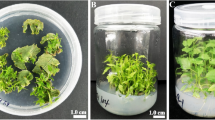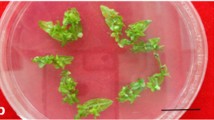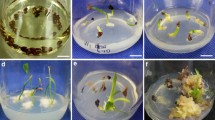Abstract
The aim was to produce a tetraploid form of Buddleia globosa to facilitate introgression of yellow flower colour into B. davidii, which is naturally tetraploid. Protocols were established for the micropropagation of B. globosa and tetraploid plants were obtained by application in vitro of colchicine to pre-cultured excised nodal sections. Three concentrations of colchicine were applied (0.01%, 0.05% and 0.1% w/v) for 1, 2 or 3 days. At 0.01% tetraploids were produced only after 2 days of application. All other treatments produced at least one tetraploid. The colchicine technique was extremely effective: of 29 lines tested, 19 were tetraploid and 5 were mixoploid. The vegetative characteristics of these tetraploids are described and the flowering characteristics of the three that flowered.
Similar content being viewed by others
References
Ackerman WL & Dermen H (1996) A fertile colchiploid from a sterile interspecific Camellia hybrid. American Camellia Yrbk 51: 35–41
Anon (1924) Floral Committee, October 2, 1923. J. Roy. Hort. Soc. 49: xciii–xciv
Duron M & Morand JC (1978) Amélioration de l'état sanitaire de Buddleia davidii 'Opera' par culture de méristèmes. Ann. Phytopathol. 10: 371–374
Fiala JL (1988) Lilacs The Genus Syringa. (pp 188) Timber Press, Bromley
James DJ, Mackenzie KAD & Malhotra SB (1987) The induction of hexaploidy in cherry rootstocks using in vitro regeneration techniques. Theor. Appl. Genet. 73: 589–594
Ma Y, Byrne DH & Chen J (1997) Amphidiploid induction from diploid rose interspecific hybrids. HortScience 32: 292–295
Moore RJ (1947) Cytotaxonomic studies in the Loganiaceae. I. Chromosome numbers and phylogeny in the Loganiaceae. Am. J. Bot. 34: 527–538
Murashige T & Skoog F (1962) A revised medium for rapid growth and bioassays with tobacco cultures. Physiol. Plant. 15: 473–497
Sax K (1947) Plant breeding at the Arnold Arboretum. Arnoldia 7: 9–12
Tobutt KR (1993) Inheritance of white flower colour and congested growth habit in certain Buddleia progenies. Euphytica 67: 231–235
Tobutt KR & Keep E (1985) Breeding ornamental varieties. Rep. E. Malling Res. Stn. 1984, 199
Van de Weyer W (1920) Hybrid Buddleias. The Gardeners' Chronicle 68: 181
Yeates M & Webster T (1992) The clonal selection scheme for ornamental trees and shrubs. Plantsman 14: 34–40
Author information
Authors and Affiliations
Rights and permissions
About this article
Cite this article
Rose, J.B., Kubba, J. & Tobutt, K.R. Induction of tetraploidy in Buddleia globosa . Plant Cell, Tissue and Organ Culture 63, 121–125 (2000). https://doi.org/10.1023/A:1006434803003
Issue Date:
DOI: https://doi.org/10.1023/A:1006434803003




